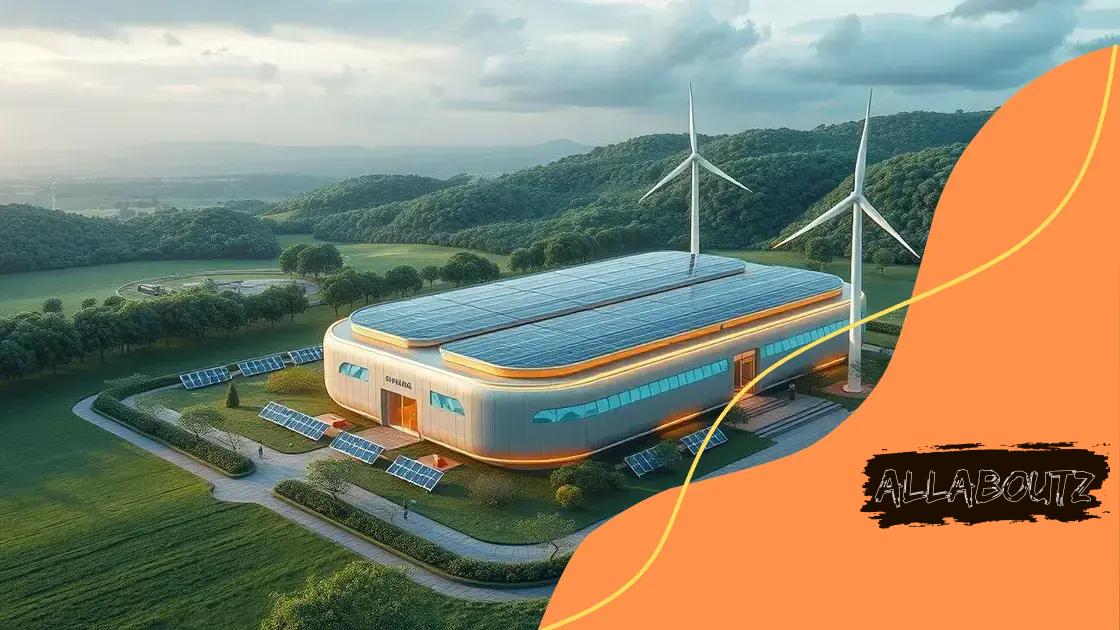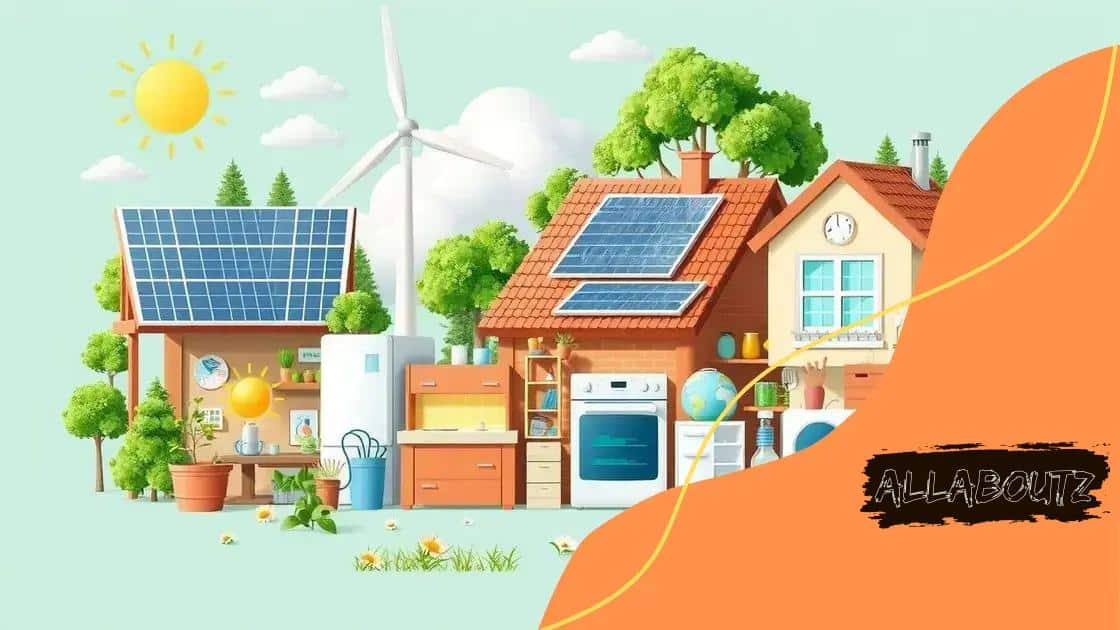Green tech innovations in energy storage

Green tech innovations in energy storage are transforming energy management through advanced battery technologies, integration with renewables, and smart systems that enhance efficiency and sustainability for homes and businesses.
Green tech innovations in energy storage are revolutionizing the way we store and use energy. Imagine a world where renewable energy sources are accessible and efficient, allowing homes and businesses to reduce their carbon footprint. In this journey, let’s uncover the latest breakthroughs and their potential impact.
Understanding green tech in energy storage
Understanding green tech in energy storage is essential for anyone interested in sustainable energy solutions. As our planet faces challenges like climate change, these technologies offer innovative ways to store and use energy efficiently.
What is Green Tech?
Green tech refers to technology that aims to reduce environmental impacts. This includes renewable energy sources, energy-efficient systems, and sustainable materials. By incorporating these technologies into energy storage, we can significantly cut emissions.
Key Concepts in Energy Storage
- Battery Technology: Advances in battery technology, including lithium-ion and solid-state batteries, are pivotal in improving energy storage capacity.
- Grid Storage: Systems like pumped hydro storage and flywheels help manage energy flow on the electric grid efficiently.
- Renewable Integration: Energy storage allows for better integration of renewable sources, like solar and wind, into our daily energy use.
These components work together to create a smart energy ecosystem. With the right technology, stored energy can be used when it is most needed. For instance, solar energy collected during sunny days can power homes at night.
Furthermore, green tech innovations not only help with energy storage but they also enhance overall energy efficiency. This is vital as we shift towards more renewable energy sources.
Real-World Examples
Around the globe, cities are adopting green technologies for energy storage. For example, countries like Germany have implemented extensive battery storage systems to balance energy supply and demand.
In summary, grasping the importance of green tech in energy storage allows us to appreciate how innovation can pave the way for climate-friendly solutions. By embracing these technologies, we can ensure cleaner energy for future generations.
Key innovations transforming energy storage
Key innovations are transforming energy storage into a more efficient and sustainable process. With ongoing advancements, we are witnessing a shift toward cleaner technology that addresses our energy demands.
Next-Generation Batteries
One of the most significant changes is in battery technology. New materials and designs are making batteries more powerful and longer-lasting. Solid-state batteries are a promising development, offering higher energy densities than traditional lithium-ion batteries.
- Increased Safety: Solid-state batteries reduce the risk of leaks and fires.
- Faster Charging: These innovations allow for quicker recharge times, improving usability.
- Longer Lifespan: New chemistries increase the overall life cycle of the battery.
Additionally, advancements in battery recycling are crucial. As batteries reach the end of their life, efficient recycling methods help recover valuable materials. This not only conserves resources but also minimizes environmental impact.
Grid Energy Storage Solutions
Innovations aren’t limited to batteries alone. Grid energy storage solutions like pumped hydro storage and compressed air energy storage are becoming more prevalent. These systems can store excess energy generated from renewable sources and release it when needed.
This capability is essential for managing energy supply and demand. For instance, renewable sources like wind and solar produce energy intermittently. Energy storage systems ensure that the energy is available during peak usage times, enhancing grid stability.
Moreover, demand response technologies allow consumers to adjust their energy usage based on real-time availability. This dynamic interaction promotes energy efficiency and reduces costs.
Smart Technology Integration
The integration of smart technologies into energy storage systems plays a vital role as well. Smart grids, equipped with sensors and automation, improve the management of energy flows. This connectivity allows for better monitoring and optimization of energy usage.
Embracing these key innovations in energy storage is crucial as we transition towards a more sustainable future. By understanding these developments, we can leverage them for greater energy efficiency and environmental stewardship.
Benefits of green tech in energy efficiency

The benefits of green tech in energy efficiency are vast and impactful. Implementing these technologies can lead to significant savings and environmental advantages.
Cost Savings
One of the primary benefits is cost savings. By using energy-efficient technologies, businesses and homeowners can reduce their energy bills. This is achieved through better insulation, energy-efficient appliances, and smart technology that optimizes consumption.
- Lower Utility Bills: Reduced energy consumption translates directly to lower monthly bills.
- Incentives and Rebates: Many governments offer financial incentives for energy-efficient upgrades, reducing upfront costs.
- Long-Term Savings: Energy-efficient products often last longer and require less maintenance.
Additionally, green technology reduces the demand for energy from fossil fuels, leading to overall cost reductions in energy production.
Environmental Impact
Another key benefit of green technology is its positive impact on the environment. By utilizing clean energy solutions, we can significantly lower carbon emissions and pollution. Renewable energy sources such as solar, wind, and hydroelectric power are much cleaner than traditional sources.
This shift not only helps combat climate change but also leads to cleaner air and water. Health benefits arise from reduced pollution levels, improving overall public health. Furthermore, reduced reliance on fossil fuels lessens the environmental degradation associated with extraction and transportation.
Enhanced Energy Security
Implementing green tech promotes energy security. As more homes and businesses adopt renewable energy systems, dependency on external energy sources decreases. This reduces vulnerability to energy price fluctuations and supply shortages.
Additionally, local energy production fosters economic resilience. When communities generate their energy, they keep more money circulating locally, supporting local jobs and economies.
Overall, the benefits of green tech in energy efficiency are clear. From financial gains to healthier environments and strengthened energy security, these innovations play a crucial role in our sustainable future.
Real-world applications of energy storage
Real-world applications of energy storage showcase how innovative technologies are reshaping our energy landscape. These applications demonstrate the effectiveness of energy storage in various settings.
Residential Energy Storage
Homeowners are increasingly adopting energy storage systems such as batteries to complement their solar panels. This allows them to store excess energy generated during the day for use at night.
- Energy Independence: Home energy storage can reduce reliance on the grid.
- Cost Efficiency: Storing electricity during off-peak hours can lower utility bills.
- Emergency Backup: Home battery systems provide power during outages.
As technology progresses, products like the Tesla Powerwall have gained popularity, making residential storage more accessible.
Commercial and Industrial Use
Businesses are harnessing energy storage solutions to enhance their operations. For example, large-scale batteries are used to manage peak demand, reducing costs associated with high energy usage.
Companies can store energy during low-demand periods and utilize it when rates spike. This not only saves money but also contributes to grid stability.
Many industries are investing in energy storage to achieve sustainability goals. By integrating renewable sources and storage, companies can significantly cut their carbon footprint.
Utility-Scale Storage
At a larger scale, utilities employ energy storage systems to balance supply and demand. These systems allow for the smooth integration of renewable energy sources like wind and solar into the grid.
Utilities can store excess energy generated during peak production times and release it when demand is high. This capability enhances grid reliability and minimizes the need for fossil fuel-based power plants.
Projects around the world demonstrate the benefits of large-scale energy storage. For example, energy storage facilities in California help address challenges posed by variable renewable energy sources.
Electric Vehicle (EV) Integration
Electric vehicles are another exciting application of energy storage. EV batteries can not only store energy but also serve as potential power sources for homes and the grid.
This vehicle-to-grid (V2G) technology allows EVs to discharge stored energy back into the grid during high demand. Such integration promotes energy efficiency and enhances the value of electric vehicles.
The real-world applications of energy storage are transforming how we understand and utilize energy in our daily lives, demonstrating the importance of innovation in creating a sustainable future.
Future trends in energy storage technology
Future trends in energy storage technology are set to revolutionize how we manage and utilize energy. As the demand for cleaner and more reliable energy sources increases, several trends are emerging that promise to enhance energy efficiency and sustainability.
Advanced Battery Technologies
One of the most significant trends is the development of advanced battery technologies. Researchers are exploring new materials, such as sodium-ion and lithium-sulfur batteries, that could outperform traditional lithium-ion batteries.
- Higher Energy Density: New battery designs promise higher energy storage capacity.
- Faster Charging: Innovations are leading to quicker charge times, enhancing user convenience.
- Lower Costs: As technology advances, production costs will likely decrease, making energy storage accessible to more people.
These advancements will make it easier for consumers and businesses to adopt energy storage solutions, leading to a more sustainable energy future.
Integration with Renewable Energy Sources
Another important trend is the integration of energy storage systems with renewable energy sources, like solar and wind. This combination is crucial for maximizing the use of renewable energy.
Energy storage allows for the capture and storage of excess energy generated during peak times, ensuring that it is available when demand is high. This helps to smooth out the fluctuations in energy production and enhances grid reliability.
Smart Energy Management Systems
Future technology will also include smart energy management systems that utilize artificial intelligence. These systems can optimize energy use by analyzing data in real-time.
For instance, smart grids can predict energy demands and manage storage systems accordingly. This not only improves efficiency but also reduces the overall carbon footprint of energy consumption.
Decentralized Energy Storage Solutions
Decentralized energy storage solutions are gaining traction as communities embrace local energy production. This trend supports the shift from centralized power plants to localized energy systems.
By implementing community energy storage, groups can pool resources and share generated energy. This approach promotes resilience and energy independence, ultimately benefiting local economies.
Overall, the future of energy storage technology looks promising. With continuous advancements and innovations, we are on the path to building a more sustainable energy landscape that meets future demands effectively.
FAQ – Frequently Asked Questions about Energy Storage Technology
What are the benefits of energy storage systems?
Energy storage systems provide cost savings, enhance energy reliability, and support the integration of renewable energy sources.
How do advancements in battery technology impact energy storage?
Advancements in battery technology lead to higher energy density, faster charging times, and lower costs, making energy storage more accessible.
What role does AI play in energy management?
AI optimizes energy use by analyzing data in real-time, helping to manage demand and improve efficiency in energy consumption.
Can decentralized energy storage benefit communities?
Yes, decentralized energy storage promotes local energy independence, enhances resilience, and keeps more energy savings within the community.





